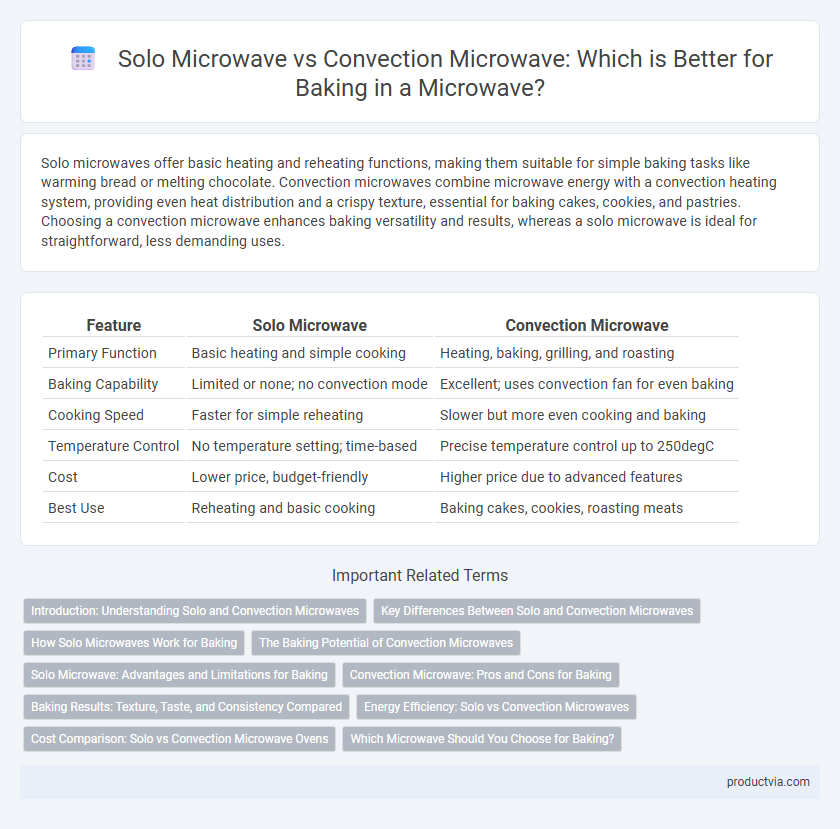Solo microwaves offer basic heating and reheating functions, making them suitable for simple baking tasks like warming bread or melting chocolate. Convection microwaves combine microwave energy with a convection heating system, providing even heat distribution and a crispy texture, essential for baking cakes, cookies, and pastries. Choosing a convection microwave enhances baking versatility and results, whereas a solo microwave is ideal for straightforward, less demanding uses.
Table of Comparison
| Feature | Solo Microwave | Convection Microwave |
|---|---|---|
| Primary Function | Basic heating and simple cooking | Heating, baking, grilling, and roasting |
| Baking Capability | Limited or none; no convection mode | Excellent; uses convection fan for even baking |
| Cooking Speed | Faster for simple reheating | Slower but more even cooking and baking |
| Temperature Control | No temperature setting; time-based | Precise temperature control up to 250degC |
| Cost | Lower price, budget-friendly | Higher price due to advanced features |
| Best Use | Reheating and basic cooking | Baking cakes, cookies, roasting meats |
Introduction: Understanding Solo and Convection Microwaves
Solo microwaves utilize microwave radiation solely for heating and reheating food, making them ideal for simple cooking tasks but limited in baking capabilities. Convection microwaves combine microwave energy with a built-in heating element and fan, enabling even heat distribution and precise temperature control ideal for baking and roasting. Understanding the functional differences highlights why convection microwaves outperform solo models in baking performance and versatility.
Key Differences Between Solo and Convection Microwaves
Solo microwaves utilize microwave radiation solely for heating and reheating food, making them ideal for simple cooking tasks, while convection microwaves combine microwave energy with a heating element and fan, facilitating even baking and roasting. Convection microwaves provide superior temperature control and uniform heat distribution, which is essential for baking delicate items like cakes and pastries. Solo microwaves lack the ability to brown or crisp food, a feature that convection microwaves excel at due to their combined cooking technology.
How Solo Microwaves Work for Baking
Solo microwaves use microwave radiation to heat food by agitating water molecules, enabling quick and uniform baking for simple recipes like cakes and cookies. Unlike convection microwaves, they do not have heating elements or fans, which limits their ability to brown or crisp baked goods. Ideal for users seeking fast heating with basic baking needs, solo microwaves lack advanced baking features found in convection models.
The Baking Potential of Convection Microwaves
Convection microwaves enhance baking results by combining microwave energy with a heating element and fan, ensuring even heat distribution and crisp, golden finishes. Unlike solo microwaves that solely use microwave radiation for reheating or basic cooking, convection models replicate traditional oven baking, making them ideal for cakes, pastries, and bread. This versatile functionality allows users to achieve professional-quality baked goods with reduced cooking times in a compact kitchen appliance.
Solo Microwave: Advantages and Limitations for Baking
Solo microwaves offer simplicity and affordability, making them suitable for basic reheating and defrosting tasks rather than complex baking. Their lack of additional heating elements like a grill or fan limits even heat distribution, resulting in inconsistent baking results compared to convection microwaves. Ideal for quick warming, solo microwaves are less effective for recipes requiring precise temperature control and browning.
Convection Microwave: Pros and Cons for Baking
Convection microwaves offer even heat distribution and faster cooking times, making them ideal for baking cakes, cookies, and bread with a crispy crust and moist interior. Their built-in fan circulates hot air, which promotes thorough and consistent baking but can sometimes cause uneven browning if not monitored carefully. However, convection microwaves are typically more expensive and larger in size compared to solo microwaves, requiring more space and investment for users seeking versatile baking options.
Baking Results: Texture, Taste, and Consistency Compared
Solo microwaves provide basic heating with uneven baking results, often leading to inconsistent texture and less optimal taste due to lack of air circulation. Convection microwaves use a built-in fan and heating element for even heat distribution, producing a more consistent bake with superior crust texture and enhanced flavor. For precise baking outcomes, convection microwaves outperform solo models by delivering uniform cooking and better moisture retention.
Energy Efficiency: Solo vs Convection Microwaves
Solo microwaves consume less energy by using basic microwave radiation for heating, making them more energy-efficient for simple reheating or defrosting tasks. Convection microwaves combine microwave radiation with a heating element and fan to bake and roast, which generally requires higher energy consumption but offers better cooking versatility. For baking specifically, convection microwaves use more energy but achieve more even cooking and browning compared to solo models.
Cost Comparison: Solo vs Convection Microwave Ovens
Solo microwave ovens typically cost less than convection microwaves due to their simpler technology and limited functionality focused on basic heating and reheating tasks. Convection microwave ovens, which combine microwave heating with a convection fan for baking and roasting, have higher prices reflecting their versatility and advanced features. Investing in a convection microwave offers greater cooking flexibility but with increased upfront costs compared to the more budget-friendly solo models.
Which Microwave Should You Choose for Baking?
A convection microwave is ideal for baking because it combines microwave energy with a fan and heating element to evenly distribute heat, producing crispy and well-cooked baked goods. Solo microwaves lack the convection feature, limiting them to reheating and simple cooking tasks without achieving the browning or texture required for baking. For consistent and quality baking results, choosing a convection microwave is the optimal solution.
Solo Microwave vs Convection Microwave for Baking Infographic

 productvia.com
productvia.com